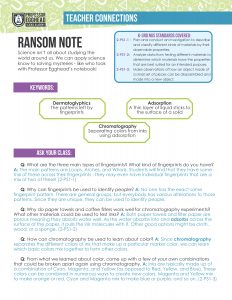Oh no! Someone broke into the Academy and ran off with the Professor’s Prized Notebook! Looks like we have no choice but to (quite literally) get our hands dirty and use some good ol’ Forensic Science to get to the bottom of this. If that fails, we can always create a Chromatogram and attempt to match the specific mixture of dyes in the ink used to write the note. Phew! Better get started.
Keywords
- Mixture
- Adsorption
- Chromatogram
- Arch/Loop/Whorl
- Dermatoglyphics
materials list
- Sharpened Pencil
- Tape
- Paper or Optional Worksheet
- Variety of colored markers.
- White coffee filter (or paper towel) cut into strips
- Glass of water
- Optional: Black Sharpie, Black Crayola Marker, Black Dry Erase Marker, and Black Vis a Vis Marker (none are integral to the experiment)
background
Fingerprinting is a common use of forensic sciences. If you look at your fingers, you see a bunch of different lines and shapes. Those lines are there to help us hold onto things better. If we didn't have them, everything would feel really slippery. When we touch objects, a little bit of oil from our fingers get left behind in the same pattern as those lines - that leaves a fingerprint. In general there are 3 main types of patterns of fingerprints - the Arch, Whorl, and Loop. While they look similar, there are actually no two fingerprints that are exactly alike! The shapes our fingerprints make and the study of them is called Dermatoglyphics. The word comes from the greek word for skin - derma - and the greek work for carvings or writing - glyph.
Another way to test items to solve a mystery is using something called chromatography. This is when you find out the parts that make up a mixture by pulling them apart. Mixtures are two or more chemicals that have been combined, but can be separated again - like a bowl full of M&Ms and skittles!. Black ink is typically made up of a mixture of several other ink colors. In this experiment we’ll see how to separate the different pigments that make up the different marker inks through a process called Chromatography. For this you need to use something called ADSORPTIVE PAPER in which a liquid like water can stick to its surface in a thin layer. The water gets pulled along the adsorptive paper, filling in small holes and spreading through it. The key to chromatography is that the various colors used in marker dyes don’t all move the same amount through adsorptive paper because of their chemical composition. Because these colors get drawn out different amounts over the paper, you can see all the different dyes present in any given marker or pen. The picture made when the inks adsorb through the paper is called a CHROMATOGRAM.
keywords
MIXTURE: When chemicals are combined, but can be separated again.
ADSORPTION: When a thin layer of liquid sticks to the surface of a solid.
CHROMATOGRAM: The picture made when colors adsorb through paper
ARCH/LOOP/WHORL: Patterns in fingerprints.
DERMATOGLYPHICS: The pattern made by fingerprints
science standards
2-PS1-1: Plan and conduct an investigation to describe and classify different kinds of materials by their observable properties.
2-PS1-2 : Analyze data obtained from testing different materials to determine which materials have the properties that are best suited for an intended purpose.
2-PS1-3 : Make observations to construct an evidence-based account of how an object made of a small set of pieces can be disassembled and made into a new object.

